Grand Piano Construction
Inside a Grand Piano

http://www.concertpitchpiano.com/index.html
1. Frame: Is sometimes called the plate or harp. It is made of iron, and supports the tension of the strings. The tension in a 9 foot concert grand piano is 30 tons. Near the bottom of the frame, where the small holes are located, is known as the pinblock. The turning pins which the strings are attached to, are inserted inside.
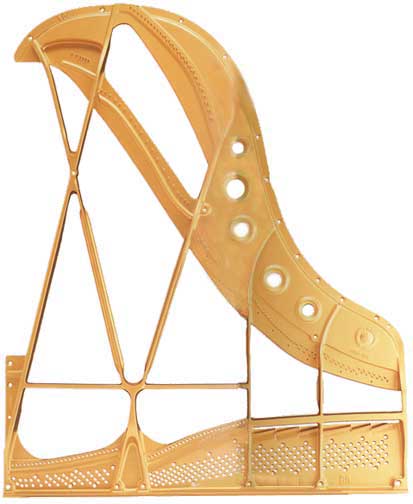
http://www.lindebladpiano.com/index.htm
2. Soundboard: Usually made of Sitka spruce wood, and about 3/8'' thick. The soundboard serves to amplify the sound produced by the vibrating strings. The wood has the correct balance of thickness and flexibility to efficiently transmit sound. The soundboard is bowed slightly upward towards the strings to maintiain compression. This keeps it from caving under the pressure of the strings, and allows for a more vibrant sound to be produced. The treble strings are attached to the long curving bridge, while the bass strings are attached to the shorter one(The top view of soundboard). The bridge then transmits the vibrations from the strings to the soundboard.
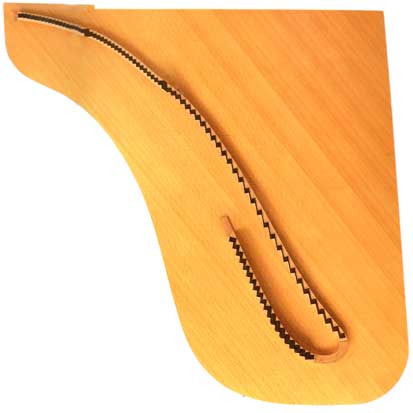 |
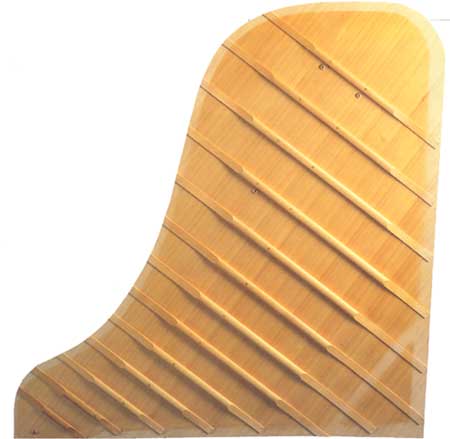 |
Top view of soundboard |
Bottom view of soundboard |
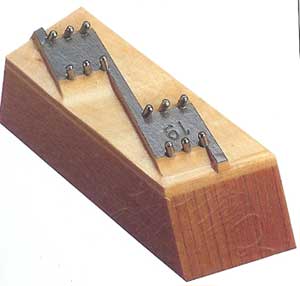 |
Bridge and bridgepins, located on top of soundboard |
http://www.lindebladpiano.com/index.htm
3. Strings: There are over 200 strings in a piano. Each treble note ususally has 3 strings per pitch, the upper bass notes have 2 strings per pitch, and the lower bass notes have one string per pitch. The reason for this, is that the treble notes are composed of thinner strings. In order to produce an equally loud sound, more strings must be used. While treble notes are made of steel, the base notes have a steel core with copper winding. The allow for the string to vibrate freely, and still have enough thickness to produce the low pitch. In order to save space, and still fit the long base strings into the piano case; the base strings cross diagonally over the treble strings.
A view of the strings attached to the turning pins
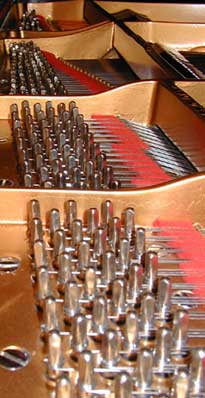
http://www.lindebladpiano.com/index.htm
5. Pedals: There are three pedals on the modern grand piano.
A. The pedal to the right is called the damper pedal. It raises all the dampers off the strings together. It is used to build a harmony from notes played successively because the notes are 'sustained' after their keys have been released and new notes can be added to the sustained sound. In addition, free strings will vibrate in sympathy with the struck strings, enriching the harmonies.
B. The pedal to the left is called the 'soft' pedal or 'una corda'. On a grand piano, a soft pedal shifts the whole keyboard and action sideways to re-align the hammers so they strike only two out of three treble strings and deliver a glancing blow to the single bass strings. When invented, pianos were less powerful and the hammers really did strike only one string in the treble. Apart from making a softer sound, this mechanism allows the unstruck string to vibrate sympathetically, creating a rather pleasing effect.
C. Some grand pianos have a middle pedal called the sostenuto pedal. This is an amazing aspect of the piano. Just like the damer pedal, it holds a raised damper off the string, but it has no effect on dampers of notes played after the pedal is pressed. The notes of the keys that were held down when the sostenuto pedal was pressed down are sustained but new notes cannot be added to the sustained harmony. The sostenuto pedal is typically used to sustain a bass note while the upper harmony changes, or to sustain a lower harmony while the melody is not sustained.
D. Some grand pianos will also have a fourth pedal that alters the striking distance or the key depth so as to reduce the momentum of the hammers when they strike the strings.
6. Case: The rim case consists of an outer and inner part. The frame and soundboard are attached to the inner rim. A good piano will consist of an outer rim and inner rim as one whole. But on many pianos, the outer rim consists of differend wood, and is attached to the inner rim case. Typical wood for the case is maple, spruce, and beech.
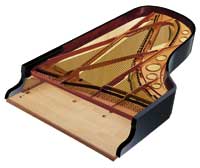 |
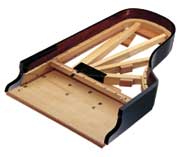 |
http://www.schimmel-piano.de/e/flgklang.html
Main Page
Before the Piano
Progress of the Piano
The Action Mechanism
Bibliography